Brand, branding strategy, branding… What is this all about?
You have probably already heard these terms and have done something about branding.
But the most important question is, are you strategic enough when you approach your branding activities?
In more than 20 years of experience working with small businesses, especially startups, I have seen that entrepreneurs usually only think about the business name, logo, and tagline when implementing branding strategy.
After developing these three brand elements, they think they have already finished with the branding strategy. Yes, these are part of the breeding strategy part of brand identity, but they are not all elements. There is a difference between branding strategy and brand identity (we will talk about this later).
I would like to share my experience with branding, especially in developing a branding strategy for your small business. Remember, the most valuable element of your small business can be your brand.
In this article, we will discuss the following:
- Defining important terms related to branding, such as brand, branding strategy, brand identity, etc., often confuses business owners.
- The importance of branding strategy and how it can drive business growth.
- What are the elements of a strong brand strategy, and what are the different types of branding strategies, and how do you choose the right one?
- And specific steps that will help you develop a successful brand strategy.
What is a Brand Strategy?
Before we proceed with the meaning of brand strategy, I would like to start with other terms like brand.
What is a brand?
A brand represents a concept we use in the business and marketing world that enables customers to easily recognize a specific company, product, or service and, more importantly, distinguish the company from its competitors.
Conversely, a brand identity is the mixture of different brand messaging and visual elements created to help consumers identify a company, product, or service. Later, we will cover more about this.
When we talk about branding, it is a process or practice that combines brand positioning (to differentiate the company from competitors), brand identity, and other key elements to building a distinctive identity that will shape customer perception. In short, branding is the business differentiation process that helps people recognize and remember specific companies.
I want to mention one more term here: brand development or brand development strategy.
On the other hand, brand development is the process of building and maintaining your brand. Brand development answers the question of how you will build and maintain a successful brand for your business.
Also, we must mention brand equity, which is a brand’s influence level on the target audience through brand awareness, reputation, loyalty, perception, and brand association.

Now, let’s see what branding or brand strategy is.
As the name tells us, branding strategy is a strategy or plan of action steps you must take for your brand development process if you want to differentiate your business from the competition, which defines how you want to present your brand to your current and potential customers.
Remember that branding strategy is not the same as business strategy. A business strategy is an overall strategy for your business that will help you achieve your goals and vision. Brand strategy is more about the specifics related to how you want your target customers to see, perceive, and remember your brand.
So, your branding strategy is your long-term plan for developing your brand image as something extraordinary in the eyes of your target audience so that they will choose your business over the competition.
Why is Developing a Branding Strategy Important?
It is really important to understand the importance of your branding strategy and the difference it can make for your small business.
When I often talk with my clients about their brand, they think they will be recognized as a quality brand if they have quality products and services. But, in reality, this is not the case. Quality is important, but it is only one fraction of your total offer and representation as a company.
Increased Brand Recognition
If someone asked you to choose between a “ChingBang” laptop and a MacBook laptop, what would you choose if the price is the same?
You may choose a MacBook laptop because you immediately recognize it and relate it to the Apple brand.
Better Advertising
To have better advertising, you must first have a strong brand. It is much easier when you already have your identity, brand story, brand marketing strategy, branded marketing kit, etc. – everything inside your brand strategy to advertise your business than without these elements.
What story do I want to convey to my customers? What brand colors to use? What tone of voice to use?
With your branding strategy, you will have answers to these questions before you start spending money on your advertising.
Costumes Loyalty and Trust
One of the purposes of your brand strategy is to generate strong trust and loyalty to your brand from your customers.
Effective branding will help you to show your target customers that you are a credible and trustworthy company. They will know what they can expect from your business, so communication and building strong relationships with them will be much easier.
Increase Your Sales
You know how important sales is for your business. Without sales, you will have less income, you will not be profitable, and eventually, you will start losing money.
But, when you have a brand that is recognizable as a trustworthy and credible brand, it is easier to sell to those customers.
15 Elements of a Strong Brand Strategy
If you want to create a strong brand strategy that will really help your business to differentiate in the market, you must ensure that your strategy will include the following elements:
1. Brand Purpose
Simply put, brand purpose responds to the question of why the company exists and what the brand wants to achieve.
2. Brand Vision
The second important element of all branding strategies is a brand vision, or where you look at your brand in the future.
3. Brand Values
As we already discussed in 15 questions to help you define your core values, core values are what your business stands for, your principles or life philosophy, and the reason for your company’s existence. These core values must be reflected in your brand values and incorporated into your brand strategy.
4. Brand Awareness Goals
When you define your brand values, you can define the next element: brand awareness goals. Brand awareness goals are specific objectives you will set to increase brand awareness in the eyes of your target audience.
5. Competitive Research
The next element of your brand strategy concerns conducting competitive analysis as a part of your market research. These 22 competitive analysis questions can help you beat your competitors.
Regarding competitive research for your brand strategy, you must answer the question: how do your competitors brand themselves? What branding tactics are they using, and are they successful or not? What is your brand positioning according to competitors’?
Remember, you want to collect information about your competitors to find their experience and some gaps that can position your brand better than theirs.

6. Target Audience
The next element you need to describe inside your strategy if you want to develop an effective brand strategy is your target audience. Who is your target audience that your brand wants to reach
7. Brand Personality
Probably, you don’t want your company to sound like a robot. Living in the social age, including a brand personality inside your brand strategy is necessary. Brand personality is all human elements in your tone of voice that will help build unique relationships with your target audience.
8. Emotions
Because your brand will talk to humans, you must include emotions inside your brand strategy. How will you connect with your target audience on an emotional level? Use emotional triggers like desire, fear, sadness, trust, happiness, belonging, anger, etc.
10. Brand Consistency
Your brand strategy also must answer the question of how you will ensure consistency when it comes to your brand. This means you must ensure that how you present your brand and how your brand communicates with your target audience will remain the same regardless of the communication and advertising channels you will use.
11. Brand Flexibility
On the other hand, brand strategies must also ensure flexibility. The business world is not static; it changes over time. This dynamic will require brand flexibility.
This can sound contradictory to you because we talk about consistency inside the previous element of the brand strategy. So, how can you be consistent and flexible at the same time?
Remember that consistency requires having some tone of voice and brand messaging standards when communicating with current and potential customers. Conversely, flexibility is required to adjust some of your branding tactics regarding the changes in your company’s environment.
12. Strong Brand Identity
Now, we come to one of the most visible elements of your brand strategy – strong brand identity. This element includes everything that visually defines your brand, like name, logo, brand tagline, brand visual elements, brand voice and tone, typography, color scheme, designs, packaging, etc., and that can improve customer experience.
So, in this part of your comprehensive brand strategy, you must specifically define each element that will be part of your strong visual identity.
13. Loyalty Element
The next question your branding strategy will need to respond on how you will achieve and maintain brand loyalty among your current customers. Brand loyalty means that you already have people loyal to your brand. They are loyal customers, always wow your actions, share your posts on social media channels, etc.
So, there are two things you need to respond to:
- How do I build strong loyalty between my customers?
- How do you maintain and increase loyalty retention rate (the percentage of people that stay loyal to your brand after some specific period of time)?
14. Brand Guidelines
Now, based on each previous element, you must develop brand guidelines that will help you ensure your brand consistency. These guidelines will ensure a higher level of employee involvement in implementing your branding strategy through guidelines on how your brand will need to be presented in the eyes of the target audience.
15. Action Plan
Lastly, like each other strategy, your branding strategy must also contain an action plan for implementation. Why do you need a strategy if it will not be implemented?
Your branding action plan must contain the following:
- Action steps for implementation;
- Deadlines;
- Required resources;
- Responsible team for implementation and
- Targeted and achieved Key Performance Indicators (KPIs).
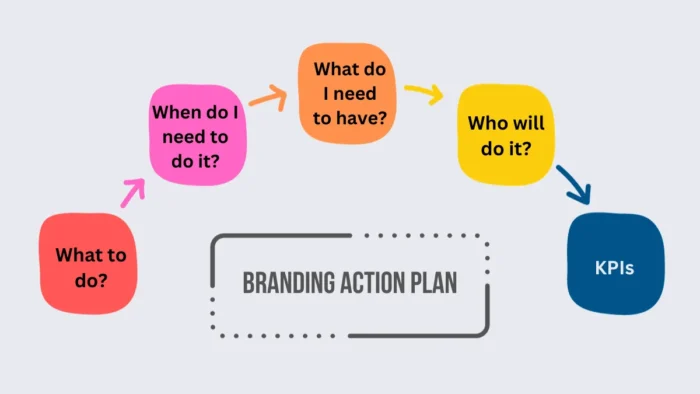
13 Types Of Branding Strategies
Before you start thinking about your brand strategy, you must keep in mind that there are different strategies you can implement. You can also have a mix of different types of strategies within your own strategy.
1. Corporate Branding Strategy
Corporate branding is a specific type of branding strategy focused on creating a brand for a company as a whole instead of specific product or service branding or some company’s identities. This branding strategy is for you if you have a wide range of products or services.
With corporate branding, all branding elements, like identity or brand story, are subordinated to the company as a whole.
2. Personal Branding Strategy
Personal branding is a branding strategy that focuses on yourself as a person and is based on your unique competencies, capabilities, talent, or perspective.
3. Product Branding Strategy
Product branding is a specific type of branding strategy that aims to create a recognizable brand for a specific product or family of products. So, the product and its specific features are central to this branding strategy, and all marketing efforts follow it.
4. Service Branding Strategy
This type of branding strategy is similar to product branding but for companies that offer services, not products. This strategy is focused on communicating the benefits that the target audience will have from specific services offered by the company.
5. Retail Branding Strategy
Retail branding is a strategy retailers use to shape their customer’s perception, typically through elements like music, signage, lighting, store design and decor, displays, and flooring to fit their image and brand story.

6. Geographical Branding Strategy
With geographical branding, you consider where your product or service is geographically available. Suppose you are a local business or business that focuses on a specific region or uses products and services that are strongly related to the geographic region. In that case, you can use a geographical brand strategy.
An example of this branding is the California wine grape farmers that have used geographic branding of their wine grapes as a key differentiation strategy.
7. Cultural Branding Strategy
Now, this is a really important strategy. Cultural branding is trying to find possible emotional connections to the target audience’s cultural context (values, core beliefs, and ideologies).
One example of cultural branding is Coca-Cola’s “Open Happiness” campaign, which started in 2009 and ended in 2015. With this branding strategy, they are not promoting their product but the lifestyle to create an emotional connection with the target audience.
8. Co-branding Strategy
Co-branding, sometimes known as a branding partnership, combines the strengths of two or more strong brands (it doesn’t matter if it is a corporate or personal brand) to bring higher values to the target audience.
One great example of this brand strategy is the partnership between Apple and Nike. This is a strategic partnership combination of product (Apple Watch or iPhone and Nike’s Fitness Tracking App) and corporate branding (Apple and Nike).
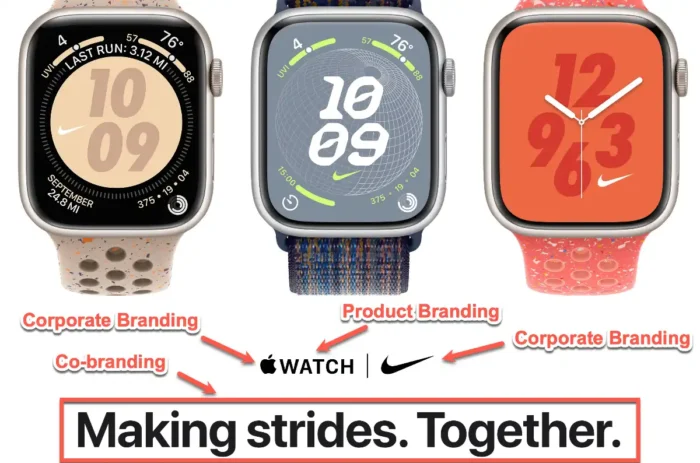
Another example can be the Nike and Michale Jordan partnership that combines Nike as a corporate brand with one of the best basketball players ever, Jordan, as a personal brand in the product brand “Air Jordan.”
9. Name Branding Strategy
Name branding is a strategy that uses the popularity of companies’ brand names to increase brand recognition on the market. If you build a strong, recognizable brand name, you can use this strategy to relate your products and services to your brand name.
10. Umbrella Branding Strategy
You use an umbrella branding strategy if you have many different brands, like product or service brands, under one parent brand.
For example, you have one parent brand like Apple and several product brands like Apple products like Mac, iPhone, Apple Watch, iPad, etc., under the umbrella of the Apple brand.
11. Brand Extension Strategy
When you have a strong brand, you can use a brand extension strategy to launch new products or services upon an already established brand.
A great example of a brand extension strategy is Google, which started as a search engine company and built brand equity based on this product. But, from then until today, they have had many other products like Gmail, Google Maps, Google Workplaces, etc., as extensions to the original product, the search engine.
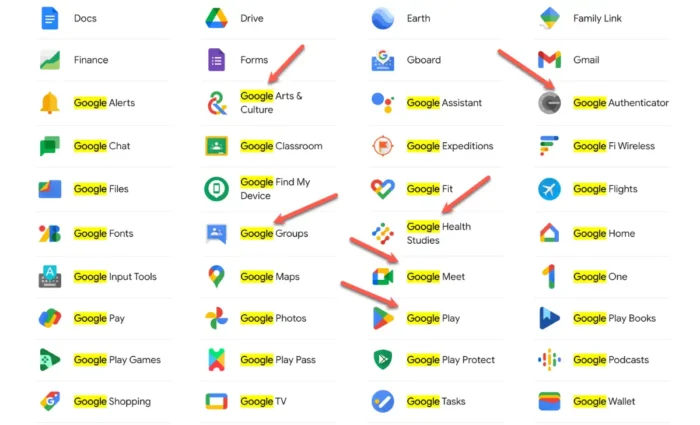
12. Online Branding Strategy
Today, we can not build a strong brand without using an online branding strategy. Regardless of what other brand strategies that we mention here you use, today, an online branding strategy is a must for every business.
Online branding strategy, or you can see that someone calls it internet or digital branding strategy, uses a website, blog, social media platforms, etc., to improve your digital visibility and positioning.
13. Offline Branding Strategy
Offline branding, on the other hand, as the name implies, is related to branding in the offline or physical world using interaction with potential customers through trade shows, billboards, print ads, etc.
How to Develop a Successful Brand Strategy?
Now that you know different brand strategies, let’s look at the steps you must take for brand development strategy.
1. Define Your Target Audience
Suppose you want to create a winning brand strategy. In that case, you must start with your target audience because they are the basis around whom you will base everything related to branding and the specific marketing strategy you will use. Here are the steps you will need to conduct to define your target audience:
- Conduct market research.
- Define your target market.
- Understand your target customer’s needs.
- Create buyer personas.
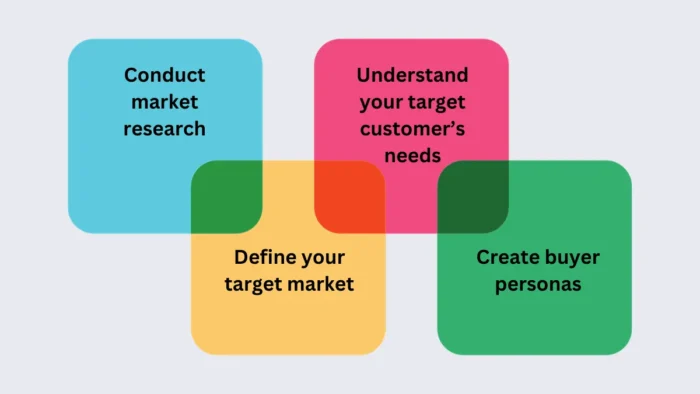
2. Establish a Unique Brand Positioning
You can start working on your brand positioning now that you know your target audience.
The main question you must respond to here if you want to develop a great brand strategy is:
How is your company different from others, and why should your target audience choose your brand instead of competitors?
Your brand positioning is all about how you differentiate your brand from the rest of the market. Beloved brands explained this like a winning zone.
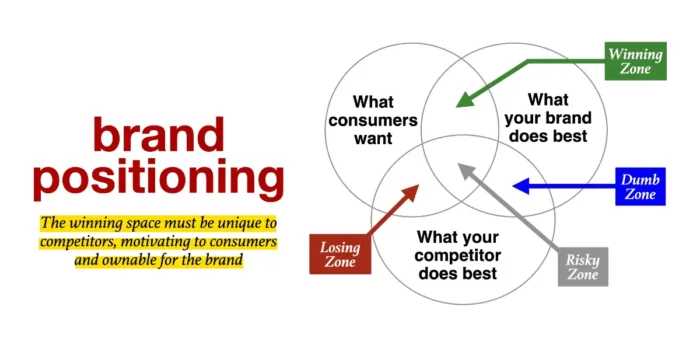
The output from these steps must be a brand positioning statement that has several sentences that describe the following:
- To whom is your brand (your target customers)?
- What are the target audience’s needs (customer needs)?
- What is the difference (differentiation from competitors)?
- What will you prove to them (benefits)?
- Why should they believe you (support points)?
You can use the following template to create your brand positioning statement’s first draft and refine it according to your needs.

3. Define Your Brand Purpose
The brand aims to answer your branding strategy’s “Why” question. For example, why does your brand exist, target that specific audience, target that specific market gap, etc.?
When defining your brand purpose, you must start with your company’s mission statement to describe what your company does, who it serves, and its core values. Here, you can find 30 examples and templates for mission statements if you don’t have one.
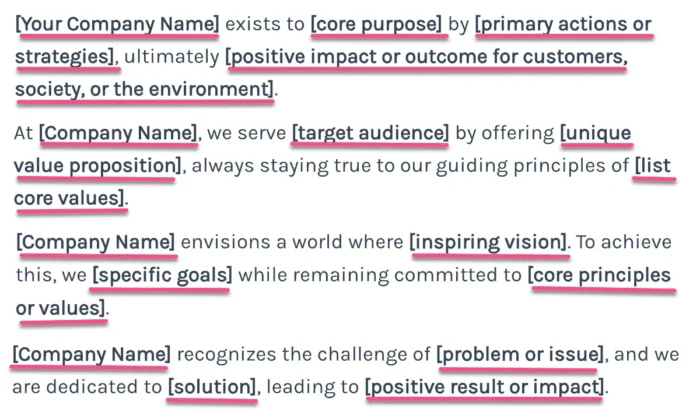
Ensure that your brand purpose will be based on your mission statement.
4. Craft a Compelling Brand Messaging
The next step is to develop your brand messaging to translate your brand positioning and purpose into clear and concise messages for your target market. You will use these messages on your marketing campaigns, social media, website, blog, etc.
Remember that creative messaging is really important when you want to share your brand values with current and potential customers. If your messages are lost in the crowded messaging today, your strategy will not succeed. In such a way, nobody will see them.
So, your messages must be creative, interesting, clear, and concise. Also, ensure you incorporate your brand voice, visual identity, and emotions into your brand message. Your brand voice needs to ensure consistency and clarity in your messages.
5. Invest in Creative Brand Guidelines
In my experience, many business owners don’t take this step seriously, and all the efforts and investments in other steps will not produce the desired results.
Why?
Strong and creative guidelines will help you ensure consistency regarding your brand. Your team members will know exactly what to include in each communication with the target customers.
Key elements you will need to include in your guidelines are the following:
- How must you use a logo on different platforms?
- Imagery guidelines or visual identity and visual story-telling elements of your brand as a guide for photographers and video creators.
- Typography, like font styles for different purposes.
- Brand voice, like tone of voice and words or sentences, should or shouldn’t be used when someone communicates on your brand’s behalf.
- Color palette or preferred color schemes.
For example, if you use Canva, you can create your unique brand kit that can be used as guidelines.
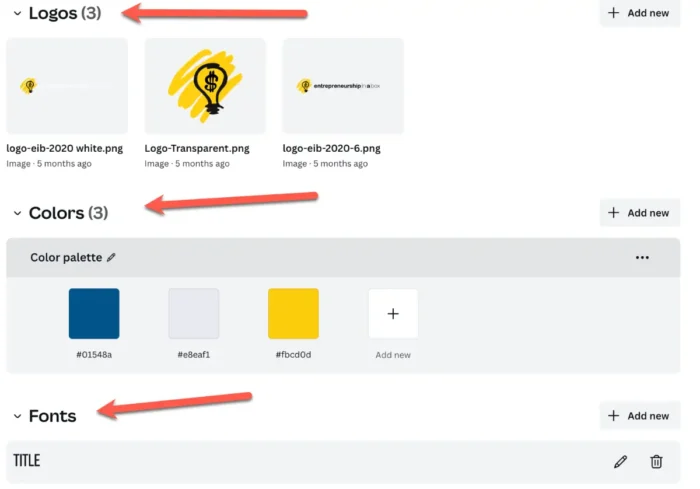
6. Develop Marketing Strategies
The next step is to develop your marketing strategies based on this brand strategy. You must align your marketing strategy and incorporate everything you have defined here. In this way, you will ensure that all your marketing materials incorporate your brand guidelines, regardless of whether we discuss online or offline strategies.
7. Implement, Track, and Improve
The last step is to start implementing your strategies according to your action plan, track the most important KPIs, and make improvements based on data collection and analysis.
Related: 100 Business Improvement Ideas for Your Small Business for 2024
How Can You Select the Right Branding Strategy for Your Business?
Now, we have already explained each aspect of your brand strategy. So, the question is how to select the most effective brand strategies that are most appropriate for your company.
Here are some things you must focus on:
1. Business Goals
A good brand strategy must align with your business goals. Remember that this strategy is something that must help you achieve your overall business goals.
So, ask yourself this question: What strategies will most efficiently help my company to achieve business goals?
2. Business Model
The next thing you must look at is related to your business model. Your strategy will depend on the value you create, how you ship that value to your customers, and how you communicate with your target market.
3. Target Market
Your target market will also influence the type of brand strategy you must select. Different demographics, needs, interests, pain points, or challenges will require the use of different strategies.
4. Industry and Competitors
Another thing you must consider when selecting the right strategy is the industry in which your brand will operate and the competitors inside that industry.
5. Budget
In the end, all of this will depend on the budget you have for your branding strategy. The strategies mentioned will require time, effort, and money investments. Some will require more and some less. So, your budget will depend on what you will choose.





